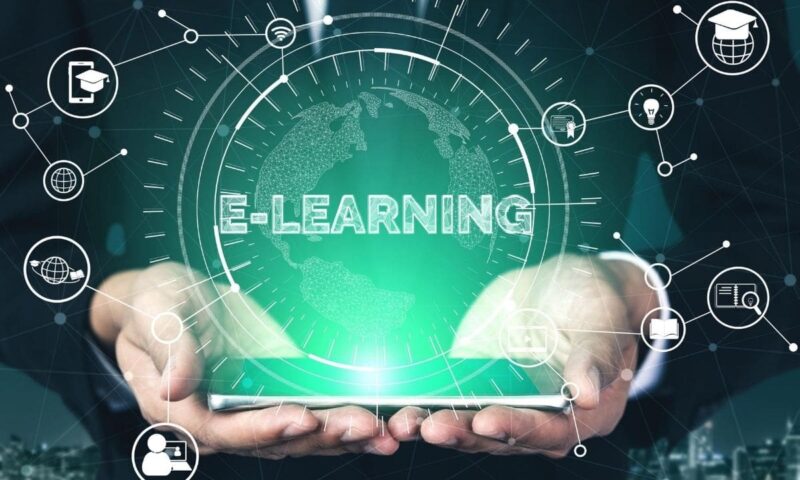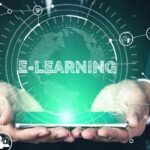What is eLearning software, and why has it become a focal point for institutions and businesses? It is the backbone for platforms that deliver, manage, and enhance the learning experience without the constraints of physical classrooms or traditional materials.
This innovative approach to education combines interactive learning content, personalized paths, and the convenience of mobile learning, offering a flexible and engaging environment for users across the globe.
The demand for eLearning solutions has surged, driven by the need for scalable, cost-effective, and accessible educational alternatives.
From Learning Management Systems (LMS) and Course Management Systems (CMS) to the integration of cutting-edge technologies like AR/VR, AI, and blockchain, e-learning software development is reshaping the way knowledge is imparted and absorbed.
Key Concepts in eLearning Software Development

- Learning management systems ─ These systems are the basis for digital learning, offering a structured environment where educators can create, deliver, and track educational content. An LMS is more than just a repository for course materials; it’s a hub for facilitating interactions, assessing performance, and managing educational courses in a digital landscape.
- Course management systems ─ Similar to LMS, CMS focuses on the administration of courses but with a heightened emphasis on content creation and curriculum management. These platforms provide educators with the tools to design, implement, and oversee courses for diverse styles and objectives.
- Adaptive technologies ─ The future of personalized education lies in adaptive learning, a method that uses AI to adjust the path based on the learner’s performance and preferences. This technology ensures that each learner’s journey is unique and addresses their strengths and areas for improvement in real-time.
- Gamification and interaction ─ By incorporating game design elements into the learning process, eLearning platforms make education both informative and engaging. Gamification fosters motivation and retention through rewards, challenges, and interactive learning content that captivates learners’ attention.
- Mobile ─ With the rise of smartphones and tablets, learning is no longer confined to the classroom or desktop. mLearning emphasizes flexibility and accessibility and allows learners to access educational content anytime, anywhere. This approach supports a lifestyle of continuous learning and adaptability to the learner’s schedule and environment.
Benefits of eLearning Software
- Accessibility and flexibility ─ One advantage is the ability to break down geographical and time barriers. Learners can access educational content from anywhere in the world at any time, making learning possible for people with busy schedules or those in remote locations.
- Scalability for users and content ─ eLearning platforms can easily accommodate a growing number of users and an expanding library of content without the need for significant physical infrastructure. This scalability helps educational programs grow to meet the needs of an increasingly diverse learner base.
- Personalized experiences ─ It excels in offering customized learning paths that cater to the individual needs, preferences, and speeds of users. Through adaptive technologies and data-driven insights, each learner can enjoy a journey that mirrors their unique learning style.
- Cost-effectiveness in long-term deployment ─ While the initial setup might require a substantial investment, the long-term benefits outweigh these costs. Digital learning eliminates the need for physical materials, reduces travel expenses, and minimizes the need for physical infrastructure, leading to considerable savings over time.
- Analytics for measuring outcomes ─ Analytics tools provide educators and organizations with actionable insights into learner engagement, progress, and outcomes. By analyzing data on how learners interact with the content, educators can refine their strategies and improve course offerings.
Considerations for Developing eLearning Software

To create platforms that genuinely make a difference in learners’ lives, developers must consider factors that contribute to the effectiveness and appeal of eLearning solutions. Here are some things to keep in mind:
- User experience design ─ A platform’s success relies on its usability and how intuitively users can navigate through it. A well-designed UX helps learners spend less time figuring out how to use the platform and more time learning. This includes clear navigation, responsive design for mobile learning, and accessibility features to accommodate all users.
- Content interactivity and engagement strategies ─ To captivate learners and keep them motivated, content must go beyond static pages and videos. Interactive elements such as quizzes, simulations, and gamification elements can boost engagement and retention. Developing content that encourages active participation rather than passive consumption can transform the experience.
- Integration capabilities with other educational tools and systems ─ No software exists in isolation. It is crucial to be able to integrate with other tools and systems, such as content management systems, student information systems, and third-party applications. This interoperability makes the learning ecosystem more flexible for both learners and educators.
- Compliance with educational standards and data security regulations ─ This includes adherence to standards like SCORM and xAPI for educational content and data protection measures to safeguard users’ information. Compliance fosters trust and credibility and broadens the solution’s acceptance and applicability.
Emerging Trends
Let’s explore some of the exciting developments that are shaping the future of eLearning.
- Augmented reality and virtual reality ─ Through virtual labs, simulations, and interactive environments, learners can explore complex concepts in a more memorable way. These technologies foster a deeper understanding by allowing learners to experience the subject matter in a controlled, virtual space.
- AI-driven personalized learning paths ─ By analyzing learner data and performance, AI can create personalized paths that adapt to each learner’s pace and style. This approach optimizes outcomes by addressing individual strengths and weaknesses.
- Blockchain for secure and transparent credentialing ─ With its decentralized and secure nature, blockchain provides a transparent platform for issuing, storing, and verifying credentials. This innovation holds the potential to facilitate the recognition of online learning across institutions and borders.
- The rise of social learning platforms ─ They integrate the social aspect of learning with digital convenience and allow users to exchange ideas, solve problems collaboratively, and learn from each other. This trend emphasizes the value of community and peer-to-peer interactions.
Challenges

Ensuring accessibility for all user groups is a primary concern. The goal is to create platforms that are universally accessible and inclusive and can accommodate learners with varying needs, abilities, and resources.
Achieving this requires a deep understanding of diverse user requirements and the implementation of design principles that cater to these needs without compromising the quality of the learning experience.
Another challenge is keeping engagement levels high among learners in a digital environment. Without the physical presence of instructors and peers, learners may feel isolated or less motivated. Addressing this issue involves crafting engaging and interactive content, integrating elements of gamification, and fostering a community through social learning features.
Technical challenges in supporting diverse devices and platforms also present a considerable obstacle. With a lot of devices and operating systems used by learners worldwide, eLearning software must be versatile and responsive.
This means making content accessible and functional across different devices, from smartphones and tablets to desktop computers. Overcoming this challenge involves meticulous planning, testing, and a commitment to embracing new technologies and standards.
Conclusion
The benefits of eLearning software, from its scalability and cost-effectiveness to the personalized learning experiences it offers, highlight the enormous potential of digital education. Along with the advancements in educational technology, such as AI, AR/VR, and blockchain, it is poised to reshape the educational landscape in ways we are only beginning to understand.
As we look to the future, the potential impact of eLearning software on education and training is immense. It promises a world where anyone, anywhere, can access high-quality education with just a few clicks.






